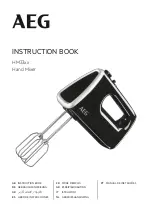
Owner's Manual
13
The line-level inputs of channels 1 and 2 can also
accept instrument-level signals if the hi-z switches
[18] are pressed in. This allows you to connect guitars
directly to channels 1 and 2, without the need for a DI
box. The input impedance is optimized for direct
connection, and high-frequency fidelity is assured.
11. STEREO LINE INPUTS (Ch. 9-16)
These 1/4" jacks can be driven by balanced or
unbalanced sources.
To connect balanced lines to these inputs, use a 1⁄4"
Tip-Ring-Sleeve (TRS) plug, wired as follows:
Tip = Positive (+ or hot)
Ring = Negative (– or cold)
Sleeve = Shield or ground
To connect unbalanced lines to these inputs, use a
1⁄4" mono (TS) phone plug, wired as follows:
Tip = Positive (+ or hot)
Sleeve = Shield or ground
If you just have a mono source, plug it into the left
input (labeled left/mono), and the signal will appear
(as if by magic) equally on the left and right of the main
mix.
12. CTRL-RM OUT
These 1/4" TRS jacks provide balanced left and right-
line-level outputs to run studio monitors in the control
room. Connect these outputs to the inputs of an
amplifier, powered speakers, or recording device.
The source that plays in the control room,
headphones, and meters can be selected using the
switches [37, 38] in the control room/phones source
matrix:
• The main mix, if main mix is selected as the
control room/phones source
• Tape outputs, if tape is selected
• Alt 3-4 outputs if alt 3-4 is selected
• A 2-track FireWire feed from your computer if
FW 1-2 is selected
• A combination of all four above
Except for main mix, whatever is playing in these
outputs can also be routed to the main mix if assign to
main mix [39] is engaged. (The main mix input to the
control room is disconnected if assign to main mix is
engaged.)
The headphones and meters play the same program
as the control room. The meters show the levels prior to
the control room and phones level controls.
13. LEFT/RIGHT 1/4" MAIN OUTPUTS
These 1/4" TRS output connectors provide the
balanced or unbalanced line-level output of the main
mix to an anxiously-waiting world. This is the same
signal that appears at the XLR main outputs [4] on the
rear panel, except it is not affected by the main output
level switch [5].
Connect these outputs to the next device in the signal
chain, such as an external processor (graphic equalizer
or compressor/limiter), external power amplifiers
running passive loudspeakers, or to the inputs of
powered loudspeakers. They could also be connected to
the inputs of a balanced 2-track recorder, when doing a
"live to 2-track" type recording.
14. ALT 3–4 OUT
These 1/4" TRS jacks provide a balanced line-level
signal that can provide an alternate stereo mix for
recording or subgrouping. Connect these outputs to the
inputs of an amplifier, powered speaker, or recording
device.
Any channel whose mute switch [33] is engaged, is
added to the alt 3-4 outputs.
The alt 3-4 output doesn’t have a master level control.
All the channels assigned to the alt 3-4 bus are summed
together (post-fader and pan) and sent directly to the
alt 3-4 out.














































